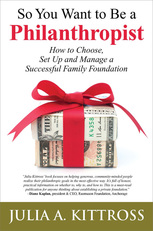 I will always tell you not to start a private foundation without a really good reason! Because the fact of the matter is that private foundations take a lot of work. First of all, each structure you choose has its accompanying required paperwork. Checkbook philanthropy requires that you keep a copy of your check and receipt for your taxes. Donor advised funds have set-up, investment and grants lists paperwork — but the entity in which you've created your DAF prepares these. Private foundations have to fill out tax returns, grant agreements, minutes, declination letters, investment and conflict of interest policies, application forms — and that's just for starters. No wonder you're drowning! First of all, identify which pieces of this work you actually enjoy (if any). Keep those. Then outsource the rest. It can be just that simple. Your attorney and investment advisors likely have policy templates. Hire a college or high school student to file papers and send out declination letters. Engage a consultant to draft guidelines, application forms, and other letters. Post a website — it can be done for free at the Foundation Center — and make sure your application information and deadlines are up to date and available to the public. Divide the tasks among your trustees or bring in the kids and grandchildren to do some of it. Hire or outsource your program officer and grant due diligence work. And most importantly, don't ask for more information from grant applicants than you actually use to make decisions! —Julia
0 Comments
 You're sitting at your kitchen table sorting through several — or dozens — of letters of request or even full proposals for funding. They all fit your focus area. They all seem like good organizations. But you can't fund them all. How do you make a good decision? In a previous entry I noted that crafting a set of decision-making criteria would enable you to make better, more effective choices. Once you've done that, you can read each appeal with those criteria in mind. You value people learning to help themselves? Then look for an organization offering proven training programs with clear pathways out of poverty. You want to help kids be successful in school and in college? Consider how long an organization tracks its clients and how it determines success. Make sure that the students aren't sent off to college only with great fanfare but also with on-going support. You believe in evidence-based activities? Search for success indicators that indicate the organization uses evidence-based practices. You get the idea.  By mid-September 2013, So You Want to Be a Philanthropist will be available on Amazon. This lively, jam-packed book will allow those thinking about setting up a family foundation to ask the questions they should — before they do. And for those with a foundation that isn't functioning as they'd hoped, this book can help get you back on the right track. I'm excited about your reactions and look forward to hearing what you think! — Julia  Don’t you find that all the new philanthropic terms are confusing? I sure do. Philanthrocapitalism, tactical philanthropy, strategic philanthropy, etc, etc. There are Blogs and magazines named with these terms, and their authors are always attempting to define their preferred phrase and why both its concept and the phrase they’ve chosen to describe it is better than another’s. An easier way to think about approaches to philanthropy was posted by Sean Stannard-Stockton on his Tactical Philanthropy Blog. [One philanthropic approach is] focused on creating and sustaining an environment within which great nonprofit organizations can thrive, while …[another] philanthropy funder focuses on developing the initiatives, goals and approaches that they believe are most likely to succeed. This difference was illustrated extremely well in a Stanford Social Innovation Review post by Amy Sample Ward where she used the difference between gardening and landscaping as an example: The Gardener creates an ecosystem open to change, available to new groups, and full of fresh opportunities to emerge naturally. The approach is focused on organic collaboration and growth for the entire community. The gardener is simply there to help, cultivate, and clear the weeds if/when they poke up. The Landscaper creates an ecosystem that matches a preconceived design or pattern. The approach is focused on executing a preconceived environment, regardless of how natural or organic it may be for the larger area. The landscaper is there to ensure that everything stays just as planned. Do you fund organizations managed by innovative and creative leaders? Are you willing to risk your grant dollars on interesting or unusual efforts? Do you let any and all nonprofits (within your focus area) apply? Do you encourage collaboration among your grantees and others in the field(s) that interest you? Then you’re a “gardener.” (Stannard-Stockton would call you a “tactical philanthropist”.) Have you thought deeply about “what works” in your field? Do you have your goals identified, your approaches chosen, an initiative developed around these goals and approaches, and a portfolio of grantees that fit into those molds? Then you’re a “landscaper.” Neither of these descriptors matter much -- what does matter, though, is that you understand your approach to grantmaking and giving, whether you’re excited to see what self-seeds or prefer to place your flowerpots just so. —Julia  "We've been 'friends' for a long time. We call. You return our call a few weeks later." So starts a short, sharp letter entitled "Dear Foundation People" from Nancy Lublin, CEO of Do Something Inc. and founder of Dress for Success. It makes you laugh, it makes you cry. OK, maybe it won't do either of those things, but it sure cracked a wry smile from me. —Julia  One of my favorite philanthropy blogs is Albert Ruesga’s White Courtesy Telephone: News, Opinions and Commentary from Inside the Third Sector. My commitment to this blog may be partially due to the fact that I’ve known Albert for many years (currently he is President & CEO of the Greater New Orleans Community Foundation), but mostly it’s because I appreciate his sense of humor and his insights. An entry about social justice philanthropy (“what’s your favorite shade of pinko?”) has a short paragraph describing how social justice philanthropy can vary: “Our work in social justice philanthropy will differ primarily along five axes: (1) our definition of social justice, (2) our goals, (3) our analysis of the problem we choose to address, (4) our choice of strategy and tactics, and (5) the values that animate our work.” This list of five axes could apply to grantmaking about any issue or from any construct. As a grantmaker, you should ask yourself if you have thoroughly thought out:
—Julia |
AuthorJulia Kittross: Archives
September 2017
Categories
All
|

Julia Kittross | Philanthropy Sherpas
[email protected] | www.PhilanthropySherpas.com | 206.334.7995
[email protected] | www.PhilanthropySherpas.com | 206.334.7995
 RSS Feed
RSS Feed